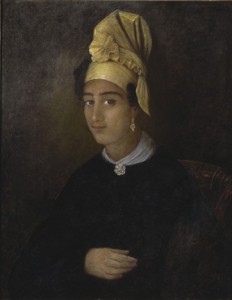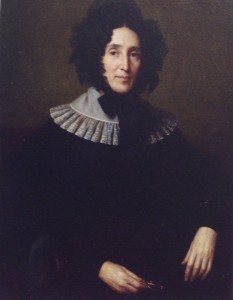Peeking from the corners of her eyes, Franz Fleischbein’s Betsy (Figure 1) poses proudly for her portrait.

She sits in a chair against a classically bare antebellum backdrop. Two tufts of her espresso-hued, curly hair spill out from the confines of her ornately wrapped, bright yellow tignon. She wears a simple black dress with a ruched white collar. Her pearl and diamond floral broach and matching earrings highlight her soft tan skin and glossy brown eyes. Betsy’s smile carries a degree of intrigue, her side-eyed gaze adding to her somewhat mischievous whimsy.
To fully comprehend Betsy, we must first understand the artist who created her. Fleischbein’s career mirrors that of his other European contemporaries. Born in Godramstein, Bavaria,[1] Fleischbein studied in Germany for most of his training and eventually showed at the Salon in Paris. Like Vaudechamp and Amans before him, Fleischbein ultimately made the pilgrimage to New Orleans, lured by the economic success of his portrait-painting predecessors.[2] Upon his arrival in the United States, perhaps in an effort to compete with his French peers, Fleischbein gallicized his name—changing it from Franz to Francois—to facilitate business with his creole clientele in New Orleans.[3]

Critiques of Fleischbein’s style are quite diverse. In general, it was understood that Fleischbein lacked the technical proficiency of his other European counterparts, keeping him out of their powerhouse Royal Street studios.[4] His artistic aesthetic led many to find his work mannered, strange, and anatomically distorted. Fleischbein’s stylistic choices—or artistic shortcomings depending on your take—are especially apparent in the boneless hands[5] of the children in his painting Comte Louis Amedeé de Barjac (figure 2), and the anatomical disproportions of his work are evident in the work of his apprentices as well.[6] Some critics attribute such features to a lack of technical skill while others have even suggested they resulted from the artist’s failing eyesight.[7] Some credited his more unique style to the influence of the German Biedermeir movement, characterizing his work as polished, meticulous, and straightforward.[8] Other hallmarks of Biedermeir used by Fleischbein include harsh light, stark modeling and lack of shade. In Biedermeir tradition, these aspects convey a sense of middle class comfort. That said, most patrons of portraiture in antebellum New Orleans belonged to the upper-middle class and resided in stately plantations.
Despite what might be perceived as technical shortcomings, Fleischbein’s Portrait of Betsy remains a captivating, thought-provoking image. Betsy was actually Fleischbein’s housekeeper,[9] making the motivation for painting her unclear. Did Betsy commission this painting on her own? Was Fleischbein painting her out of curiosity? Did he, perhaps, attempt to exoticize her and exploit her mixed-race heritage as Jacques Amans arguably does in Creole in a Red Headdress?[10]
Fleischbein gives his painting somewhat of an intimate feel due to the hints of Betsy’s personality that come through, a fact that leads some to surmise that the artist created the painting compelled by his own interest in and gratitude to a member of his household.[11] For one thing, her somewhat playful and mischievous gaze shows her personality in a non-sexual manner (her gaze is not necessarily a flirtatious

“come hither”). Betsy’s pose and unbroken gaze that appears to follow the viewer, along with the similar position of the hands, triangular composition, and comparable furtive smile, also recall the posture and expression of Da Vinci’s regal and captivating Mona Lisa (figure 3). Whether Fleischbein invokes this most famous work of the Renaissance master earnestly or playfully remains open to question.
Her dress and jewels also add another critical layer to her identity in this portrait. It is unclear as to whether these rich clothes and extravagant jewelry actually belonged to Betsy or whether the artist dressed her in this manner solely for the portrait. Regardless, her attire recalls the fashions worn by wealthy white women in other antebellum portraits. Like Jacques Amans’ 1842 Portrait of a Gentlewoman (figure 4), Betsy poses against a nondescript, dark grey backdrop which, according to

scholar Judith H. Bonner was typical for elegant portraiture displayed in the grand homes of the antebellum South.[12] Also like the sitter in Jacques Amans’ Portrait of a Gentlewoman, Betsy’s dress features a high neckline, accented by a pleated white collar. The collar signifies modesty and virtue. With this in mind, Fleischbein paints Betsy in a way that is more respectful than exoticized. She wears fine, pious fashions, highlighting her beauty and Fleischbein paints in the same manor as he would any other patron. Only her distinctive yellow tignon, a trademark of free women of color in New Orleans, signifies her race. She carries an air of refinement as she channels her inner Mona Lisa. The artist then seems more interested in capturing Betsy’s expression and personality than the hue of her skin tone. Despite her bone-less hand, Betsy’s sparkling eyes and intriguing smile continue to captivate viewers, making Fleischbein’s portrait of Betsy one of his most beautiful, popular, and lasting works.
R.C.V.
[1] Rudolph, William Keyse. In Search of Julien Hudson: Free Artist of Color in Pre-Civil War New Orleans. Page 37.
[2] Sartisky, Michael, J. Richard Gruber, and John R. Kemp. A Unique Slant of Light: The Bicentennial History of Art in Louisiana. Page 23.
[3] Delehanty, Randolph. Art in the American South: Works from the Ogden Collection. Baton Rouge: Louisiana State UP, 1996. 187. Print.
[4] McAlear, Donna. “Portraiture, Landscapes, and Marine Scenes in Nineteenth-Century Louisiana.” Collecting Passions: Highlights from the LSU Museum of Art Collection. Baton Rouge, LA: LSU Museum of Art, 2005. 42. Print.
[5] Rudolph, William Keyse. In Search of Julien Hudson: Free Artist of Color in Pre-Civil War New Orleans. Page 42.
[6] Based on HNOC research, Julien Hudson was thought to have studied under Fleischbein. This is evident in the likeness of Hudson’s Portrait of a Young Girl With a Rose to Fleischbein’s Portrait of Marie Louis Tétu. Hudson’s image suffers from the same anatomical distortions and visual flatness that characterizes Fleischbein’s work.
[7] Lewis, Richard Anthony. “Francois Jacques Fleischbein.” KnowLA Encyclopedia of Louisiana. Ed. David Johnson. Louisiana Endowment for the Humanities, 11 Jan 2011. Web 20 Feb. 2015.
[8] Sartisky, Michael, J. Richard Gruber, and John R. Kemp. A Unique Slant of Light: The Bicentennial History of Art in Louisiana. Page 40.
[9] Rudolph, William Keyse. In Search of Julien Hudson: Free Artist of Color in Pre-Civil War New Orleans. Page 42.
[10] See Object Analysis #1, Jacques Amans’ Portrait of a Creole in a Red Headdress.
[11] Rudolph, William Keyse. In Search of Julien Hudson: Free Artist of Color in Pre-Civil War New Orleans. Page 71.
[12] McAlear, Donna. “Portraiture, Landscapes, and Marine Scenes in Nineteenth-Century Louisiana.” Collecting Passions: Highlights from the LSU Museum of Art Collection. Baton Rouge, LA: LSU Museum of Art, 2005. 40-44. Print.